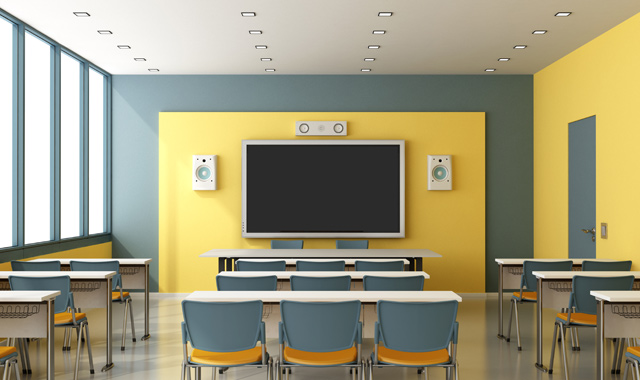
- Homeowners
- Professionals
- Products
- Back
- PlasterBoards
- Metal Framing & Accessories
- Jointing and Finishing
- Gypsum Plasters
- Ceiling Tiles
By material Type
By Category
- Resources
- About
- Careers
- FAQ's
In well designed educational spaces, students and teachers communicate more effectively, student scores trend higher and there is better retention of quality teachers and staff.
Moreover, well designed schools have a positive impact on the communities they serve.

Cleaning products, carpeting, treated fabrics and engineered wood furniture have the potential to release volatile organic compounds (VOCs), formaldehyde in particular, into the air. When inhaled, it causes a negative effect on student cognitive abilities and contributes to absenteeism among students, teachers and staff.
The specification and installation of Drywalls and ceilings with technology to reduce formaldehyde is an effective means of improving indoor air quality and positively impacting student outcomes and teacher turnover.
Good classroom acoustics has a direct impact on the clarity of communication between students and teachers, affecting both the learning process and the physical and psychological health of both.
Noise disturbances can greatly impede the transfer and absorption of knowledge as they compromise the students’ capacity to concentrate and learn, and the teachers’ ability to project their voices and control the classroom.
The negative impacts of noise on well-being include an increased heart rate, raised blood pressure and reduced oxygen in the blood. All of this translates into barriers to optimal educational achievement. For example, research has shown that reading scores for children in ‘noisy’ classrooms are around one year behind those in ‘quiet’ classrooms.
Our Drywall and ceiling acoustic solutions are purpose-built to limit noise distractions, so that students can focus and pay closer attention, can hear and be heard clearly, can concentrate when reading and preparing work, and can ultimately learn more effectively
Schools are subjected to extreme wear and tear as a result of the energetic activity, sports equipment, and rucksacks of a multitude of students.
This is especially prevalent in passageways where walls can become easily and badly damaged. In addition to affecting the aesthetics and maintenance costs, the physicality and physical obstacles can lead to injuries, putting student and staff safety at risk. Fire safety is the other major concern in schools.
Gyproc® Drywalls provide strong robustness supported by Duraline Boards that cater to the need of Impact resistance in educational institutions. Gyproc® Fireresist Drywall systems ensures protection from fire, providing fire rating upto 240 mins.
All of the parts and processes that make up a building, be the raw materials or the structural design, have a significant impact on the well-being of its inhabitants and the state of the environment.
No more so than in the case of educational settings where the younger generation is learning about the serious influence of sustainability on its future.
With our range of gypsum-based interior building products and systems, we have pledged to make a difference and urge you to follow suit when it comes to choosing sustainable products for constructing your educational facilities. Our plasterboard is 100% recyclable into new plasterboard or soil conditioner. The installation of Gyproc® systems uses less water when compared to traditional brick and block construction
EDUCATION
Project References